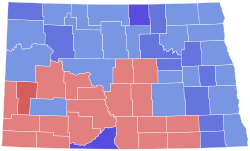| ||||||||||||||||
| ||||||||||||||||
 County results Pomeroy: 50–60% 60–70% 70–80% Clayburgh: 50–60% 60–70% | ||||||||||||||||
| ||||||||||||||||
| Elections in North Dakota |
|---|
 |
The 2002 U.S. House of Representatives election for the state of North Dakota's at-large congressional district was held November 5, 2002. The incumbent, Democratic-NPL Congressman Earl Pomeroy was re-elected to his sixth term, defeating Republican candidate Rick Clayburgh.
Contents
Only Pomeroy filed as a Dem-NPLer, and the endorsed Republican candidate was Rick Clayburgh, who was serving as the North Dakota State Tax Commissioner. Pomeroy and Clayburgh won the primary elections for their respective parties. [1]
The election was the closest for Pomeroy in all of his career as congressman until his defeat in 2010; he won by just over 11,000 votes. This was because Clayburgh ran an aggressive campaign, and was the most well-known candidate ever to face Pomeroy; he had held a statewide office for 8 years. United States Vice President Dick Cheney campaigned for Clayburgh in Fargo, North Dakota on July 29. [2]

